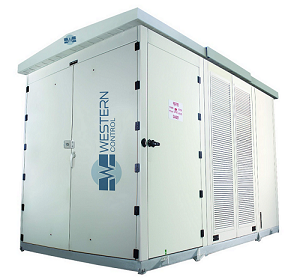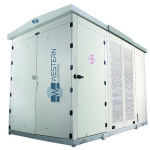
The rapid advancements in urbanization and industrialization have increased the demand for reliable, efficient, and sustainable power distribution solutions. As cities grow and infrastructure evolves, traditional methods of power distribution are being reevaluated to meet the dynamic needs of modern societies. One of the most promising developments in this area is the emergence of Compact SubStation. These innovative solutions are revolutionizing the way electrical power is distributed and managed, offering several advantages over traditional power substations. Western Control Automation Pvt. Ltd. is at the forefront of this transformation, providing cutting-edge Compact SubStation technologies to enhance the efficiency and sustainability of power distribution systems.
What is a Compact Substation?
A Compact Substation is a fully integrated, pre-constructed electrical system that incorporates the key elements of a traditional substation, but in a more streamlined and space-saving design. These substations are typically designed for urban and industrial environments where space is limited, but the demand for reliable power distribution remains high. By integrating components such as transformers, switchgear, and protection devices into a single unit, Micro Substation reduce the overall footprint compared to traditional substations, making them ideal for densely populated areas.
The Growing Need for Compact Substation
As urban populations grow and energy demands increase, the need for smarter and more compact power distribution solutions is becoming more pressing. Traditional substations, while effective, are often large, requiring significant space and high capital investment. Moreover, these substations are not always suitable for locations where land is scarce or expensive, such as in busy city centers.
This is where Compact Substation come in. They provide a solution to these challenges by offering a smaller, more modular design without compromising performance. These units can be installed in urban spaces, along highways, or near industrial facilities, helping to provide power more efficiently while minimizing the space required for infrastructure.
Key Benefits of Compact Substations
- Space Efficiency
One of the standout benefits of Compact Substations is their ability to fit into smaller spaces. Traditional substations often require extensive land areas, including room for transformers, switchgear, and other electrical components. On the other hand, compact units house all of these elements in a condensed form, which is especially advantageous for urban areas where land is at a premium. - Cost-Effective
The reduced size of a Compact Substation not only saves on land costs but also leads to overall cost savings in construction and maintenance. The modular nature of these substations also allows for faster installation, which translates into lower labor and equipment costs. Furthermore, Space-Efficient Substation tend to have a longer lifespan due to their efficient design, reducing the need for frequent replacements or repairs. - Enhanced Reliability and Safety
Compact substations are designed to provide a high level of reliability. Many of these units are equipped with modern control and protection systems that ensure the safety and stability of power distribution. These systems are often automated, reducing human intervention and minimizing the risk of operational errors. Furthermore, the compact design often includes weather-resistant enclosures, making them suitable for a variety of environmental conditions. - Flexibility and Scalability
Another key advantage of Compact Substations is their flexibility. These units can be customized to meet specific requirements, such as voltage levels and load capacities, depending on the needs of the local grid or industrial facility. Additionally, as demand for power grows, Space-Efficient Substation can be scaled up or integrated with additional units, allowing for easy expansion without significant disruption to the existing infrastructure. - Sustainability
As the world transitions to renewable energy sources, the role of compact substations is becoming even more critical. These units are designed with sustainability in mind, offering energy-efficient solutions that reduce transmission losses. Furthermore, Space-Efficient Substation can be integrated with renewable energy systems such as solar and wind, contributing to a greener and more sustainable power distribution network.
The Role of Compact Substations in Smart Grids
The integration of Mini Power Distribution Units (PDU) with smart grid technology is a groundbreaking development shaping the future of power distribution. Smart grids use digital communication, advanced sensors, and smart monitoring systems to enhance the efficiency of electricity distribution.By incorporating LT Panels and Compact Substations into these systems, utilities can achieve enhanced grid reliability, streamline energy distribution, and maintain a dynamic balance between supply and demand. With Compact Substations playing a pivotal role in reducing infrastructure footprint, the future of energy distribution is smarter, more resilient, and sustainable.
Space-Efficient Substation can serve as crucial nodes in a smart grid, offering real-time data on power usage, voltage levels, and potential faults. This information can then be used to optimize the distribution of electricity, ensuring that power is delivered where it is needed most, when it is needed most. Additionally, by integrating renewable energy sources and energy storage systems, smart grids powered by Compact Energy Hub can provide more flexible and reliable power to both consumers and businesses.
Challenges and Considerations
While Compact Substations offer numerous advantages, there are also challenges associated with their implementation. One of the main challenges is ensuring that these units meet the necessary regulatory and safety standards, as their compact design can sometimes lead to concerns about overheating or inadequate protection. However, ongoing advancements in technology are addressing these issues, making modern Portable Energy Station increasingly reliable and safe.
Another consideration is the potential for increased complexity in maintenance. Due to their smaller size and modular design, compact substations may require specialized knowledge and expertise to maintain effectively. Proper training for personnel and regular monitoring are essential to ensure that these substations continue to operate at peak efficiency.
Conclusion
The future of power distribution is undoubtedly linked to the development of Compact Substation. These innovative solutions provide a more efficient, cost-effective, and sustainable approach to managing electrical power, especially in urban areas and industries where space is limited. As the demand for reliable and flexible energy solutions continues to rise, compact substations will play an essential role in shaping the future of the global power grid. With their ability to deliver enhanced reliability, flexibility, and scalability, Miniature Power Station are poised to become a cornerstone of modern power distribution networks, driving the transition to a smarter, more sustainable energy future.






Leave a Reply